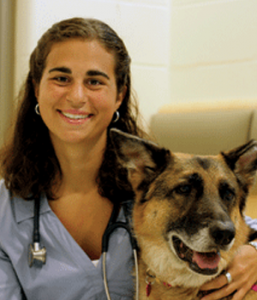-
Adopt
-
Veterinary Care
Services
Client Information
- What to Expect – Angell Boston
- Client Rights and Responsibilities
- Payments / Financial Assistance
- Pharmacy
- Client Policies
- Our Doctors
- Grief Support / Counseling
- Directions and Parking
- Helpful “How-to” Pet Care
Online Payments
Referrals
- Referral Forms/Contact
- Direct Connect
- Referring Veterinarian Portal
- Clinical Articles
- Partners in Care Newsletter
CE, Internships & Alumni Info
CE Seminar Schedule
Emergency: Boston
Emergency: Waltham
Poison Control Hotline
-
Programs & Resources
- Careers
-
Donate Now
 by Angela Mazza, DVM
by Angela Mazza, DVM
Angell General Medicine Service
angell.org/generalmedicine
617-522-7282
Your pet’s nail, or claw, is a very specialized structure that helps primarily with grasping, ambulating and defending itself. The most common claw disorders that veterinarians diagnose in pets are related to trauma, infection, cancer and auto-immune disease. Dogs are more commonly affected than cats. These disorders can cause loosening and sloughing of nails, breakage of nails, swelling of the nail bed, and abnormal positioning and growth of the nail. Any or all of these changes can be quite painful for the pet.
Trauma is the most common cause of nail problems in pets and tends to affect 1-2 nails. A traumatic disruption of the nail is not only painful, but can also increase the risk for secondary bacterial infections. Trauma can be related to an overzealous nail trim, getting the nail caught on something or even chemical burns.
A bacterial or fungal infection of the nail can be secondary to trauma, but other systemic illnesses can predispose your pet to nail infections. These can include hypothyroidism and Cushing’s disease in dogs, feline leukemia or immunodeficiency virus in cats, diabetes mellitus, allergies or cancer in either species. Bacterial and fungal infections can affect one or several nails and can often extend from the nail to the claw fold and skin of the foot. Fungal infections can be much harder to clear than bacterial infections, often requiring months of treatment, but thankfully are less common than bacterial infections.
 Unfortunately, cancer is another primary cause of some nail lesions. The most common type of cancer affecting nails is squamous cell carcinoma. Other cancers known to affect the nail and nail bed are melanomas, mast cell tumors, osteoscarcomas, and fibrosarcomas. Cancer tends to occur in older dogs and affect only one nail, but there are cases of multiple digits on multiple feet affected.
Unfortunately, cancer is another primary cause of some nail lesions. The most common type of cancer affecting nails is squamous cell carcinoma. Other cancers known to affect the nail and nail bed are melanomas, mast cell tumors, osteoscarcomas, and fibrosarcomas. Cancer tends to occur in older dogs and affect only one nail, but there are cases of multiple digits on multiple feet affected.
Auto-immune diseases occur as a result of auto antibodies produced against normal healthy cells that lead to destruction and disease. The trigger for most auto-immune disease is unknown. The most common immune diseases affecting the nail are bullous pemphigus, pemphigus vulgaris, pemphigus follieaceous, and symmetrical lupoid onychodystrophy (SLO). Auto-immune diseases most often affect more than one nail. SLO tends to be restricted to destruction of the nail and nail bed only whereas the other immune diseases can diffusely affect the skin and other mucocutaneous areas.
Depending on the extent of disease, onset, and discomfort of your pet, your veterinarian may recommend certain diagnostic tests. These can include, but are not limited to, cytology, cultures, x-rays, and in some cases, a biopsy sample may be required for a definitive diagnosis. Certain treatments can be initiated including antibiotics, pain medication and bandaging the paw while the nail heals. For cases of auto-immune disease, treatment is often more complicated, multifactorial, and often includes immunosuppressant medications such as steroids.
Depending on the cause of your pet’s nail injury, treatment may be short term and lead to complete resolution of symptoms within a few days to weeks. For other more complicated cases, treatment can be long term and some nail diseases can only be managed not cured. For this reason, it is best to have your pet evaluated by a veterinarian for any problem related to its nail especially if it causes discomfort.
For information about Angell’s General Medicine service, please visit www.angell.org/generalmedicine or call 617-522-7282.